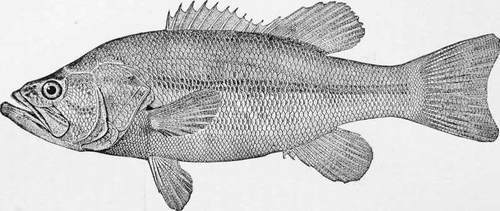Lake-Fishing
Description
This section is from the book "American Game Fishes", by W. A. Perry. Also available from Amazon: American Game Fishes: Their Habits, Habitat, and Peculiarities; How, When, and Where to Angle for Them.
Lake-Fishing
Lake-fishing will include, arbitrarily, the Great Lakes, the larger inland lakelets of Canada, Minnesota. Wisconsin, Michigan, and other States, and the lakes, lagoons, ami broad streams of the Gulf States. Presumably, a boat is always used in this kind of fishing, either with fly or bait, in which the angler is -"Cabin'd, cribb'd, confined, bound in To saucy doubts and fears."
As the Bass grow larger, on an average, and are mostly the large-mouthed species in all of these comparatively still waters, and very much larger in Florida and the Gulf States, a heavier rod may be employed than in stream-fishing. The "Henshall rods" alluded to above, when of the maximum weight of nine or ten ounces, are certainly heavy enough to meet the requirements of anyone, and for the Large-mouthed Bass of Florida (running up to twelve or fifteen pounds or more), such a rod is not too heavy, and is powerful enough withal to kill fishes of other species of twenty or thirty pounds weight. I am now speaking particularly of bait-rods, though a fly-rod need be no heavier and will be found just as effective.

Small Mouthed Black Bass. Micropterus Dolonicn.
There is a method of lake-fishing, however, that differs from ordinary Black Bass angling, and requires a somewhat different rod. I allude to the fishing about the Bass Islands in the western part of Lake Erie. The Small-mouthed Bass of this locality hibernate under the numerous ledges and cavernous, limestone reefs projecting from and lying between these islands; and when the Bass are coming out of their winter-quarters, in April and May, and just before going into them, in September and October, the fishing is very good about these reefs and ledges; but the Bass disappear from them during the summer months, being then absent on their spawning and feeding grounds in other portions of the lake, or up the streams.
There are a great many anglers who frequent Pelee, Kel-ley's, and the Bass Islands, about Put-in-Bay, every spring and fall, for this reef-fishing. Some of them are veterans in the sport, having made these semi-annual pilgrimages for twenty-five or thirty years.
As a rule, Lake Erie anglers use a very short, heavy, and stiff natural cane rod, and for this reason: The Bass lie close to the reefs and under the ledges, in water from ten to twenty feet or more in depth, and in order to get the bait (minnow) down to the reef as quickly as possible, and to keep it there, it is the custom to use very heavy sinkers, weighing from two to eight ounces, at the end of the line, the snelled hook being placed a foot or two above it, after the manner of the "dipsey" lead on the east coast. One or two artificial flies are often added to the line above the baited hook. The heavy sinker is often made to pound or strike on the rocks, ostensibly to attract the attention of the Bass. Of course it is possible to catch Bass on these reefs in the usual way-with light rods and tackle and the smallest sized sinkers and swivels, and it is the method I employ; but it is also certain that those who use the heavy sinkers catch the most fish, and for this reason it is fair to presume that this will always be the favorite method with Lake Erie anglers.
In order to induce this large class of anglers to discard the unsightly and insufficient natural cane rods of large caliber and great weight, as usually employed, I have devised a modification of the "Henshall rod" for this special fishing, which requires a short, stifnsh, and springy rod, of medium weight, in order to manipulate so heavy a sinker. It will be fully described a few pages later in this article.
Continue to:
- prev: Stream-Fishing
- Table of Contents
- next: Fly-Fishing
